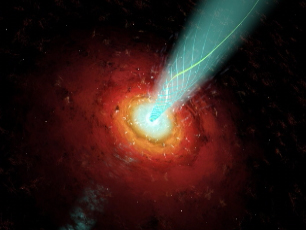Astrophysicists spot "Blazar" galaxy that emits radiation
 Washington, March 19 : An international team of astrophysicists, using telescopes on the ground and in space, has uncovered surprising changes in radiation emitted by an active galaxy classified as a Blazar.
Washington, March 19 : An international team of astrophysicists, using telescopes on the ground and in space, has uncovered surprising changes in radiation emitted by an active galaxy classified as a Blazar.
The picture that emerges from these first-ever simultaneous observations with optical, X-ray and new-generation gamma-ray telescopes is much more complex than scientists expected and challenges current theories of how the radiation is generated.
The galaxy in question is PKS 2155-304, a type of object known as a "blazar."
Like many active galaxies, a blazar emits oppositely directed jets of particles traveling near the speed of light as matter falls into a central supermassive black hole.
In the case of blazars, the galaxy is oriented such that scientists look right down the jet.
PKS 2155-304 is located 1.5 billion light-years away in the southern constellation of Piscis Austrinus and is usually a detectable but faint gamma-ray source.
But, when its jet undergoes a major outburst, as it did in 2006, the galaxy can become the brightest source in the sky at the highest gamma-ray energies scientists can detect - up to 50 trillion times the energy of visible light.
Even from strong sources, only about one gamma ray this energetic strikes a square yard at the top of Earth''s atmosphere each month.
The four identical telescopes of the High Energy Stereoscopic System in Namibia detect faint atmospheric flashes caused by the absorption of ultrahigh-energy gamma rays.
Atmospheric absorption of one of these gamma rays creates a short-lived shower of subatomic particles.
As these fast-moving particles rush through the atmosphere, they produce a faint flash of blue light.
The High Energy Stereoscopic System (H. E. S. S), an array of telescopes located in Namibia, captured these flashes from PKS 2155-304.
Gamma rays at lower energies were detected directly by the Large Area Telescope (LAT) aboard NASA''s orbiting Fermi Gamma-ray Space Telescope.
Between August 25 and September 6, 2008, the telescopes monitored PKS 2155-304 in its quiet, non-flaring state.
The results of the 12-day campaign are surprising.
During flaring episodes of this and other blazars, the X- and gamma-ray emission rise and fall together. But, it doesn''t happen this way when PKS 2155-304 is in its quiet state, and no one knows why.
"Astronomers are learning that the various constituents of the jets in blazars interact in fairly complicated ways to produce the radiation that we observe," said Fermi team member Jim Chiang at Stanford University, California.
"These observations may contain the first clues to help us untangle what''s really going on deep in the heart of a blazar," he added. (ANI)